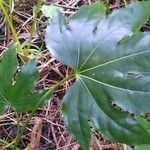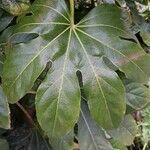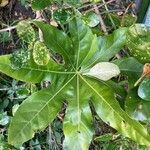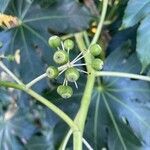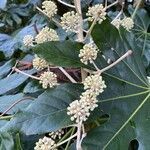Shrub or small tree up to 2-(4) m high. Stems softly hairy when young, becoming glabrous when mature; lf scars prominent. Lvs softly hairy when young, particularly below, glabrous on both surfaces when mature, alternate, broadly ovate to suborbicular, cordate, (3)-5-10-palmately lobed to c. 1/2-⅔ radius, c. (6)-15-60 cm long; lobes acute to acuminate, usually finely serrate, sometimes entire or coarsely serrate; petioles softly hairy when young, glabrous when mature, (5)-10-50 cm long. Infl. a terminal raceme or panicle of numerous-flowered globose umbels, finely hairy; petals white, c. 2.5-3 mm long. Fr. black, 5-8 mm diam.
